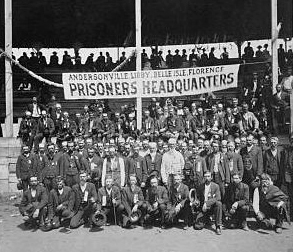St. Louis Park was not yet a village from 1861-1865, but several men from the sparsely populated area served in the war. Great thanks go to Wayne Jorgenson, who provided us with much of the following information. Jorgenson is the author of the book Every Man Did His Duty; Pictures and Stories of the Men of the First Minnesota, published in 2013 and available on Amazon.
When the American Civil War began, Minnesota’s population numbered about 172,000. Of these, an estimated 15 percent were mustered into military service to fight for the Union army.
ST. LOUIS PARK CIVIL WAR VETERANS
These are the men we know about who were from St. Louis Park or lived here later in life:
Job J. Pratt enlisted as a private in Company D in the First Regiment and was one of the veterans who transferred to the First Battalion of the Minnesota Infantry when the First Regiment was discharged. He mustered in on March 1, 1864, and mustered out on July 14, 1865. He was wounded on June 22, 1864 “Bear Petersburg.”
Martin Van Buren Pratt was in Company A, Brackett’s Battalion of Cavalry, mustered in December 11, 1861 [enlisted on September 25], mustered out October 28, 1864. [An 1890 census shows him as a Private, Company G, 5th Iowa, October 11, 1861 and that he suffered from rheumatism]
For some reason, at age 42, with the Civil War in its third year, Miles G. Pratt enlisted in the Company D of the 1st Regiment Minnesota Infantry on March 30, 1864, for a bounty of $60. Whether he made it to battle is unknown to us – he died on April 23, 1864.
Stephen Pratt, who may or may not have been related to the other Pratts, enlisted in the Minnesota Cavalry Mounted Rangers on October 9, 1862, listing his home town as Industriana, which was part of Brooklyn Township. He was mustered out as a Corporal on October 20, 1863. He had owned land in St. Louis Park in 1881.
A Thomas Gaffney was in the 10th Minnesota Infantry, who may have been the same man who had a a claim in Section 4. Gaffney enlisted as a private in August 1862 in Company K, 9th Regiment, which Norman Thomas describes as an Irish group.
Peter Hannon was in the same group as Gaffney, says Thomas.
Mark T. Berry was in Hatch’s Battalion of Cavalry, mustered in August 31, 1864, mustered out May 1, 1866. Norman Thomas reports that he was a First Lieutenant of Company E. Berry lived near Cedar Lake.
William Calahan was in the 3rd Minnesota Infantry, mustered in February 11, 1864, mustered out September 2, 1865.
George Evans Williams was born in Wales in April 1839 and came to America in 1860, just in time to enlist in the Civil War on October 28, 1861. His term was up on January 13, 1864 but he re-enlisted for another two years on March 1, 1864. During the war he was held prisoner in the notorious Andersonville Prison in Georgia for 14 months and as a result developed lung and kidney trouble. He served in a Wisconsin unit and he and his family moved to St. Louis Park in 1891.
Charles Rye was a Private in the 1st Minnesota Infantry and the 1st Battalion Minnesota Infantry from [January 1] February 24, 1864 to [August 1] July 14, 1865. He told his family of the battle of Gettysburg and other battles in Virginia and the South. A note says that his leg was injured.
Joel Barber Clough was not found in the records, but family lore is that he earned the rank of Colonel in the war, where he served as an engineer from 1863 until 1864 in charge of building military roads in Pennsylvania and Virginia. He was honorable discharged for poor health.
Walter Rice served out of Wisconsin and later moved to St. Louis Park.
Walter Ainsworth served with a New York group, reports Norman Thomas.
C.B. Heffelfinger owned land in St. Louis Park and was one of the first to enlist, having joined a group called Lincoln’s Guards.
The following three men are listed on a Special Schedule of the 1890 Census of Surviving Soldiers, Sailors and Marines, and Widows, Etc. – Persons who served in the Army, Navy and Marine Corpos of the United States during the war of the rebellion (who are survivors) and widows of such persons, in St. Louis Park, County of Hennepin, State of Minnesota, enumerated in June, 1890. Signed by James L. Davis. We could find no evidence in Census records that these men had any connection to St. Louis Park.
H. C. Parlin is shown as a Sergeant, company H, 1st Michigan Light A, from December 31, 1861, to July 10, 1885. A note says he re-enlisted twice.
William Masters was a Private in Company A, 11th Illinois. He served three years ending in May 1865, but his discharge papers were lost. He was shot in the leg and was deceased by 1890.
Benjamin Morgan was a First Lieutenant in the 3rd New York, mustered in on August 3, 1861 and discharged on September 20, 1864.
THE GRAND ARMY OF THE REPUBLIC
The GAR was a veterans organization set up after the War.
In July 1884, over 100,000 Union army veterans attended a convention of the GAR in Minneapolis. General William T Sherman and General John “Black Jack” Logan were on the reviewing stand as the veterans marched by. It was noted by the newspapers that many of the marching veterans were walking on artificial legs or had empty sleeves from their wounds.
The photo below is a group of former Union prisoners of war attending the convention. The banner behind them indicates the prisons they were held in. Andersonville was in Georgia, Libby and Belle Isle were in Richmond, and Florence was a POW camp in Alabama.

